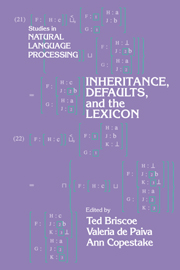Book contents
- Frontmatter
- Contents
- Contributors
- 1 Introduction
- 2 Skeptical and Credulous Default Unification with Applications to Templates and Inheritance
- 3 Prioritised Multiple Inheritance in DATR
- 4 Some Reflections on the Conversion of the TIC Lexicon into DATR
- 5 Norms or Inference Tickets? A Frontal Collision between Intuitions
- 6 Issues in the Design of a Language for Representing Linguistic Information Based on Inheritance and Feature Structures
- 7 Feature-Based Inheritance Networks for Computational Lexicons
- 8 A Practical Approach to Multiple Default Inheritance for Unification-Based Lexicons
- 9 The ACQUILEX LKB: An Introduction
- 10 Types and Constraints in the LKB
- 11 LKB Encoding of Lexical Knowledge
- 12 Defaults in Lexical Representation
- 13 Untangling Definition Structure into Knowledge Representation
- Appendix A A Bibliography of ACQUILEX Papers Connected with the LKB
- Appendix B The LKB Description Language Syntax
- Appendix C Software Availability
- References
- Author index
- Subject Index
9 - The ACQUILEX LKB: An Introduction
Published online by Cambridge University Press: 01 April 2010
- Frontmatter
- Contents
- Contributors
- 1 Introduction
- 2 Skeptical and Credulous Default Unification with Applications to Templates and Inheritance
- 3 Prioritised Multiple Inheritance in DATR
- 4 Some Reflections on the Conversion of the TIC Lexicon into DATR
- 5 Norms or Inference Tickets? A Frontal Collision between Intuitions
- 6 Issues in the Design of a Language for Representing Linguistic Information Based on Inheritance and Feature Structures
- 7 Feature-Based Inheritance Networks for Computational Lexicons
- 8 A Practical Approach to Multiple Default Inheritance for Unification-Based Lexicons
- 9 The ACQUILEX LKB: An Introduction
- 10 Types and Constraints in the LKB
- 11 LKB Encoding of Lexical Knowledge
- 12 Defaults in Lexical Representation
- 13 Untangling Definition Structure into Knowledge Representation
- Appendix A A Bibliography of ACQUILEX Papers Connected with the LKB
- Appendix B The LKB Description Language Syntax
- Appendix C Software Availability
- References
- Author index
- Subject Index
Summary
Introduction
This chapter and those following describe the LKB, a lexical knowledge base system which has been designed as part of the ACQUILEX project to allow the representation of syntactic and semantic information semi-automatically extracted from machine readable dictionaries (MRDs) on a large scale. An overview of the ACQUILEX project is given by Briscoe (1991).
Although there has been previous work on building lexicons for Natural Language Processing (NLP) systems from MRDs (e.g. Carroll and Grover, 1989), most attempts at extracting semantic information have not made use of a formally defined representation language; typically a semantic network or a frame representation has been suggested, but the interpretation and functionality of the links has been left vague. Several networks based on taxonomies extracted from MRDs have been built (following Amsler, 1980) and these are useful for tasks such as sense-disambiguation, but are not directly utilisable as NLP lexicons. For a lexicon to be genuinely (re)usable, a declarative, formally specified, representation language is essential. A large lexicon has to be highly structured; it is necessary to be able to group lexical entries and to represent relationships between them, both in order to capture linguistic generalisations and to achieve consistency and conciseness. But, unless these notions of structure are properly specified, a lexicon based on them is in danger of being incomprehensible except (perhaps) to its creators.
- Type
- Chapter
- Information
- Inheritance, Defaults and the Lexicon , pp. 148 - 163Publisher: Cambridge University PressPrint publication year: 1994
- 1
- Cited by



